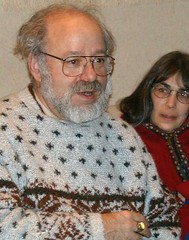
Seed: The Evolution of Language: "FOXP2 evolved to its present form roughly 200,000 years ago, and perhaps as recently as 120,000 years ago. The era in which this change transpired was a very interesting one: It is when the explosion of modern human behaviors appears in the fossil record, and was the likely time of the last migration out of Africa. Is it possible that this mutation simply produced better-sounding, less-slurred speech? It seems unlikely. What show up in the archeological record around this time are drastically different human behaviors. For instance, Marta Camps and I have shown that there is no evidence for the ability to tie and untie knots prior to the FOXP2 mutation. No other animals besides humans can tie or untie knots, and based on its computational complexity, it seems likely that this ability is a parasite, piggybacking on the mechanics of language. It was knots which then gave us the means to produce footwear, arrows, jewelry, and other similar objects not observed prior to this time. The mutation in FOXP2, therefore, came in concert with some deep advances in cognitive abilities that are unique to humans."
.....
"
Finches have long been the subjects of behavior studies because they exhibit a form of acquisition related to vocal learning. Young male finches acquire the songs they will use later to woo females by imitating other males during a critical period of a few weeks after hatching. Indeed, brain studies have shown the finch's brain has two important circuits for singing, one for acquisition and another for performance. Interestingly, FoxP2 (lowercase for other animals' variants) is expressed for both circuits in a brain region called Area X while the finches are first acquiring their songs and also when they later begin to sing.
"Finches do not just imitate one another; they are creative, and compose parts for their own songs. Again, this is not speech in any sense of the term, and to the best of our knowledge these songs have no patterns of meaning. This behavior does however share some abstract properties with language. Their songs reflect a type of grammar with so-called trills and flourishes. Could the fact that FoxP2 regulates it be merely accidental?"\
...
"The connection between humans and songbirds goes even deeper than all this. The finch's FoxP2 differs from the human's in only eight out of 200,000 positions, and the brain circuit that operates during birdsong is functionally equivalent to one of the subcortical brain circuits involved in human language. The reason the birds do not exhibit language, then, is probably because their brains just lack much of the outer cortex that we have."
....
"We are just thinking apes, with a finch's ability to sing."



No comments:
Post a Comment